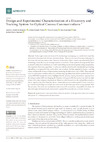Identificador persistente para citar o vincular este elemento:
https://accedacris.ulpgc.es/jspui/handle/10553/107076
| Título: | Design and experimental characterization of a discovery and tracking system for optical camera communications | Autores/as: | Mederos-Barrera, Antonio Jurado Verdú, Cristo Manuel Guerra Yánez, Víctor Rabadán, José A. Perez-Jimenez, Rafael |
Clasificación UNESCO: | 3325 Tecnología de las telecomunicaciones | Palabras clave: | Detection System Discovery System K Parameters Optical Camera Communications Test System For Tracking Systems, et al. |
Fecha de publicación: | 2021 | Proyectos: | Arquitecturas Opticas Hibridas Para Ciudades Inteligentes | Publicación seriada: | Sensors (Switzerland) | Resumen: | Visible light communications (VLC) technology is emerging as a candidate to meet the demand for interconnected devices’ communications. However, the costs of incorporating specific hardware into end-user devices slow down its market entry. Optical camera communication (OCC) technology paves the way by reusing cameras as receivers. These systems have generally been evaluated under static conditions, in which transmitting sources are recognized using computation-ally expensive discovery algorithms. In vehicle-to-vehicle networks and wearable devices, tracking algorithms, as proposed in this work, allow one to reduce the time required to locate a moving source and hence the latency of these systems, increasing the data rate by up to 2100%. The proposed receiver architecture combines discovery and tracking algorithms that analyze spatial features of a custom RGB LED transmitter matrix, highlighted in the scene by varying the cameras’ exposure time. By using an anchor LED and changing the intensity of the green LED, the receiver can track the light source with a slow temporal deterioration. Moreover, data bits sent over the red and blue channels do not significantly affect detection, hence transmission occurs uninterrupted. Finally, a novel experimental methodology to evaluate the evolution of the detection’s performance is proposed. With the analysis of the mean and standard deviation of novel K parameters, it is possible to evaluate the detected region-of-interest scale and centrality against the transmitter source’s ideal location. | URI: | https://accedacris.ulpgc.es/handle/10553/107076 | ISSN: | 1424-8220 | DOI: | 10.3390/s21092925 | Fuente: | Sensors [ISSN 1424-8220], v. 21 (9), 2925, (Mayo 2021) |
| Colección: | Artículos |
Citas SCOPUSTM
9
actualizado el 08-jun-2025
Citas de WEB OF SCIENCETM
Citations
7
actualizado el 08-jun-2025
Visitas
201
actualizado el 30-nov-2024
Descargas
135
actualizado el 30-nov-2024
Google ScholarTM
Verifica
Altmetric
Comparte
Exporta metadatos
Los elementos en ULPGC accedaCRIS están protegidos por derechos de autor con todos los derechos reservados, a menos que se indique lo contrario.
